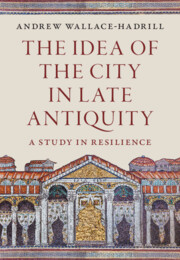Book contents
- The Idea of the City in Late Antiquity
- Praise for The Idea of the City in Late Antiquity
- The Idea of the City in Late Antiquity
- Copyright page
- Dedication
- Contents
- Figures
- Preface
- 1 The End of the Ancient City?
- 2 In Praise of the City
- 3 The City in Question
- 4 The City Revived?
- 5 The City Embattled
- 6 The City and Its Records
- 7 The City of Bishops
- 8 The Grammar of the City
- 9 The Fabric of the City
- 10 Decline and Resilience
- Bibliography
- Index
7 - The City of Bishops
Gregory of Tours and Merovingian Gaul
Published online by Cambridge University Press: 30 January 2025
- The Idea of the City in Late Antiquity
- Praise for The Idea of the City in Late Antiquity
- The Idea of the City in Late Antiquity
- Copyright page
- Dedication
- Contents
- Figures
- Preface
- 1 The End of the Ancient City?
- 2 In Praise of the City
- 3 The City in Question
- 4 The City Revived?
- 5 The City Embattled
- 6 The City and Its Records
- 7 The City of Bishops
- 8 The Grammar of the City
- 9 The Fabric of the City
- 10 Decline and Resilience
- Bibliography
- Index
Summary
The History of the Franks of Gregory of Tours, along with his Saints’ lives, show a world of cities that maps with surprising accuracy onto the administrative world of late Roman Gaul. The squabbling Merovingian kings treat cities almost as stocks and shares, something of value worth fighting over, valued for their resources and taxes and manpower. From the perspective of Gregory as bishop, he and his fellow bishops play a central role in city administration. Yet they too are descendants of the local land-holding elite, with whom their interests align. The idea that city councils have disappeared is based on a misinterpretation of the senatores, who are simply Gregory’s way of describing the old landed elite who held office in cities. The bishop, as representative of the church and its land-holdings, proves to be the key figure in the adaptation of the old order.
- Type
- Chapter
- Information
- The Idea of the City in Late AntiquityA Study in Resilience, pp. 236 - 270Publisher: Cambridge University PressPrint publication year: 2025

